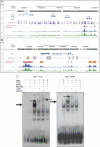Aryl hydrocarbon receptor-mediated induction of Stearoyl-CoA desaturase 1 alters hepatic fatty acid composition in TCDD-elicited steatosis
- PMID: 21890736
- PMCID: PMC3216411
- DOI: 10.1093/toxsci/kfr226
Aryl hydrocarbon receptor-mediated induction of Stearoyl-CoA desaturase 1 alters hepatic fatty acid composition in TCDD-elicited steatosis
Abstract
2,3,7,8-tetrachlorodibenzo-ρ-dioxin (TCDD) induces hepatic dyslipidemia mediated by the aryl hydrocarbon receptor (AhR). Stearoyl-CoA desaturase 1 (Scd1) performs the rate-limiting step in monounsaturated fatty acid (MUFA) synthesis, desaturating 16:0 and 18:0 into 16:1n7 and 18:1n9, respectively. To further examine the role of Scd1 in TCDD-induced hepatotoxicity, comparative studies were performed in Scd1(+/+) and Scd1(-/-) mice treated with 30 μg/kg TCDD. TCDD induced Scd1 activity, protein, and messenger RNA (mRNA) levels approximately twofold. In Scd1(+/+) mice, hepatic effects were marked by increased vacuolization and inflammation and a 3.5-fold increase in serum alanine aminotransferase (ALT) levels. Hepatic triglycerides (TRGs) were induced 3.9-fold and lipid profiling by gas chromatography-mass spectroscopy measured a 1.9-fold increase in fatty acid (FA) levels, consistent with the induction of lipid transport genes. Induction of Scd1 altered FA composition by decreasing saturated fatty acid (SFA) molar ratios 8% and increasing MUFA molar ratios 9%. Furthermore, ChIP-chip analysis revealed AhR enrichment (up to 5.7-fold), and computational analysis identified 16 putative functional dioxin response elements (DREs) within Scd1 genomic loci. Band shift assays confirmed AhR binding with select DREs. In Scd1(-/-) mice, TCDD induced minimal hepatic vacuolization and inflammation, while serum ALT levels remained unchanged. Although Scd1 deficiency attenuated TCDD-induced TRG accumulation, overall FA levels remained unchanged compared with Scd1(+/+) mice. In Scd1(-/-) mice, TCDD induced SFA ratios 8%, reduced MUFA ratios 13%, and induced polyunsaturated fatty acid ratios 5% relative to treated Scd1(+/+) mice. Collectively, these results suggest that AhR regulation of Scd1 not only alters lipid composition but also contributes to the hepatotoxicity of TCDD.
Figures






References
-
- Attie AD, Flowers MT, Flowers JB, Groen AK, Kuipers F, Ntambi JM. Stearoyl-CoA desaturase deficiency, hypercholesterolemia, cholestasis, and diabetes. Nutr. Rev. 2007;65:S35–S38. - PubMed
-
- Attie AD, Krauss RM, Gray-Keller MP, Brownlie A, Miyazaki M, Kastelein JJ, Lusis AJ, Stalenhoef AF, Stoehr JP, Hayden MR, et al. Relationship between stearoyl-CoA desaturase activity and plasma triglycerides in human and mouse hypertriglyceridemia. J. Lipid Res. 2002;43:1899–1907. - PubMed
-
- Bank PA, Yao EF, Phelps CL, Harper PA, Denison MS. Species-specific binding of transformed Ah receptor to a dioxin responsive transcriptional enhancer. Eur. J. Pharmacol. 1992;228:85–94. - PubMed
-
- Bank PA, Yao EF, Swanson HI, Tullis K, Denison MS. DNA binding of the transformed guinea pig hepatic Ah receptor complex: Identification and partial characterization of two high-affinity DNA-binding forms. Arch. Biochem. Biophys. 1995;317:439–448. - PubMed

